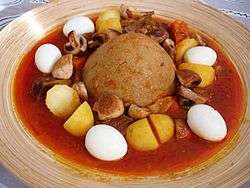Libyan cuisine
Libyan cuisine is the cooking traditions, practices, foods and dishes associated with the country of Libya. The cuisine derives much from the traditions of the Mediterranean, North Africa (Tunisian cuisine), and the Middle East (Egyptian cuisine). One of the most popular Libyan dishes is a thick highly spiced soup, known simply as Shorba Arabiya,[1] or "Arabian soup". Shorba Arabiya contains many of the ingredients from many other Libyan dishes, including onions, tomatoes, lamb (or chicken), chili peppers, cayenne pepper, saffron, chickpeas, mint, cilantro and parsley.[2] Pork consumption is forbidden, in accordance with Sharia, the religious laws of Islam.[3] Tripoli is Libya's capital, and the cuisine there is particularly influenced by Italian cuisine.[3] Pasta is common, and many seafood dishes are available.[3] Southern Libyan cuisine is more traditionally Arab and Berber. Common fruits and vegetables include figs, dates, oranges, apricots and olives.[3]
Common foods and dishes


Bazin is a common Libyan food made with wheat flour and a little plain flour, which is boiled in salted water to make a hard dough, and then formed into a rounded, smooth dome placed in the middle of the dish. The sauce around the dough is made by frying chopped onions with lamb meat, turmeric, salt, cayenne pepper, black pepper, fenugreek, sweet paprika, and tomato paste. Potatoes can also be added. Finally, eggs are boiled and arranged around the dome. The dish is then served with lemon and fresh or pickled chili peppers, known as amsyar. Batata mubattana (filled potato) is another popular dish that consists of fried potato pieces filled with spiced minced meat and covered with egg and breadcrumbs.
Additional common foods and dishes include:
- Asida is a dish made up of a cooked wheat flour lump of dough, sometimes with added butter, honey or rub.
- Breads,[3] including flatbreads
- Bureek, turnovers
- Couscous, a North African dish of semolina
- Ghreyba, butter cookies[1]
- Harissa is hot chili sauce commonly eaten in North Africa. Main ingredients include chili peppers, such as bird's eye chili and serrano peppers, and spices such as garlic paste, coriander, red chili powder, caraway and olive oil.[4]
- Hassaa, type of gravy[1]
- Magrood, date-filled cookies[1]
- Mhalbiya, type of rice pudding[1]
- Mutton, meat of an adult sheep[3]
- Rub is a thick dark brown, very sweet syrup extracted from dates or carob that is widely used in Libya, usually with Asida.
- Shakshouka is prepared using aged mutton or lamb jerky as the meat base of the meal, and is considered a traditional breakfast dish.
- Shorba, lamb and vegetable soup with mint and tomato paste[3]
- Tajine, spiced lamb with a tomato and paprika sauce[3]
- Usban, a traditional Libyan sausage
Beverages
Libyan tea is a thick beverage served in a small glass, often accompanied by peanuts.[3] Regular American/British coffee is available in Libya, and is known as "Nescafé" (a misnomer). Soft drinks and bottled water are also consumed.[3] The Maghrebi mint tea is also a popular drink. All alcoholic drinks have been banned in Libya since 1969,[3] in accordance with Sharia, the religious laws of Islam.
See also
References
- 1 2 3 4 5 "Libyan Food." Libyana.org. Accessed June 2011.
- ↑ In Libya, for Starters, It's the Soup in New York Times
- 1 2 3 4 5 6 7 8 9 10 11 "Libya." Foodspring.com. Accessed June 2011.
- ↑ Maloufshomt, Greg (2008). Artichoke to Za'atar: Modern Middle Eastern Food. U of California P. p. 70. ISBN 978-0-520-25413-8.
